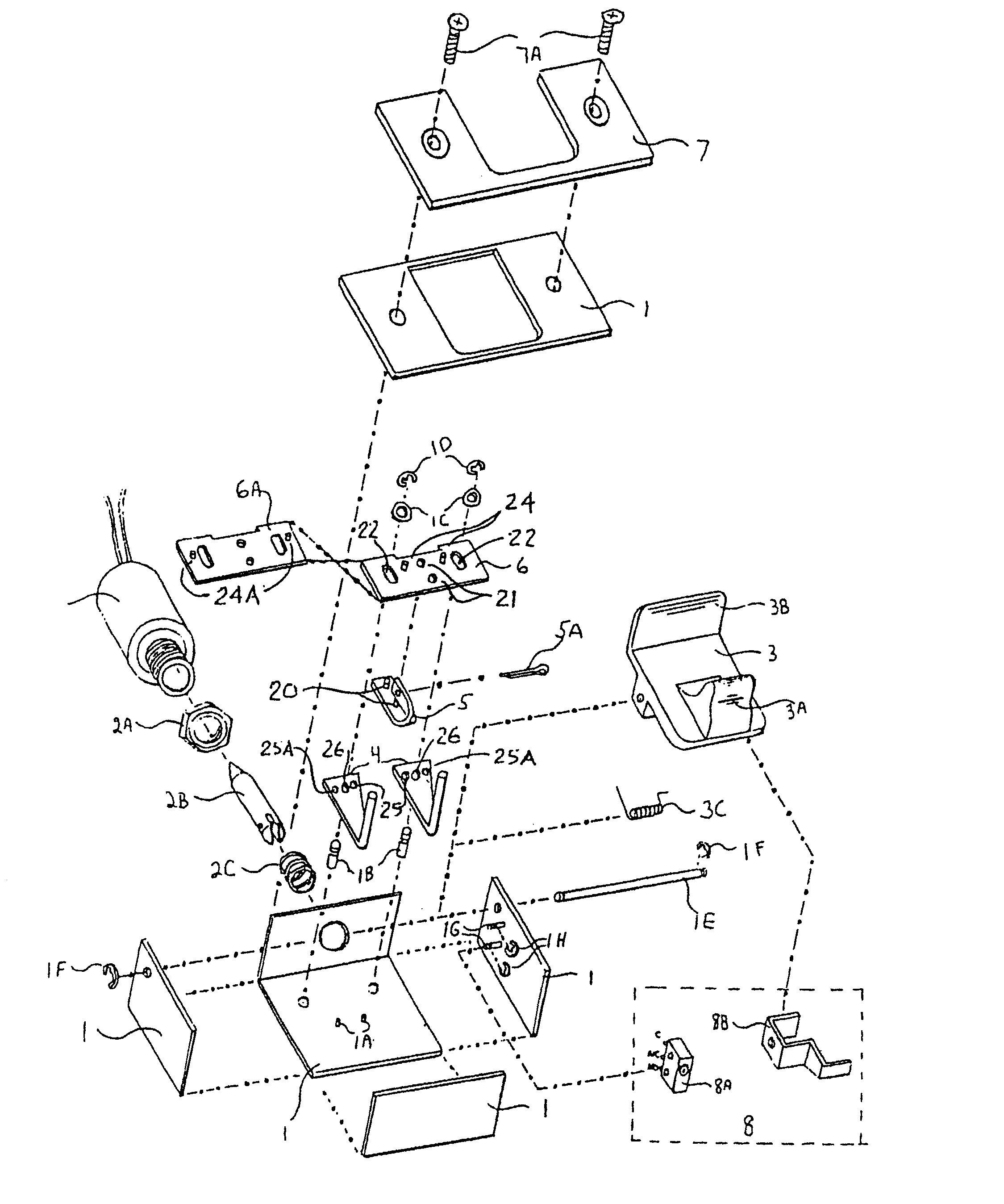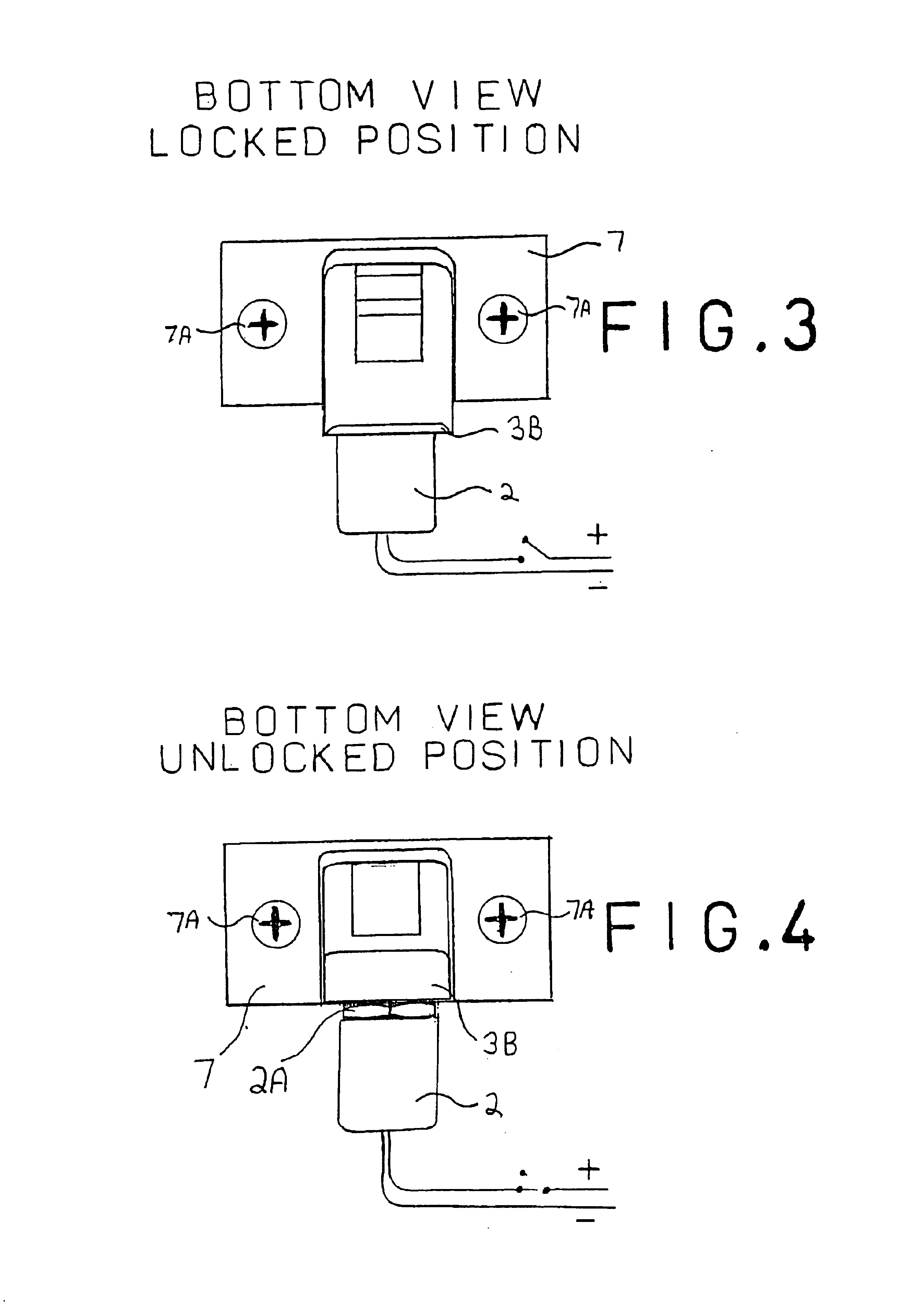[0013]Advantages of the invention include: its size; its ability to be field configured for fail-safe and fail-secure operation; its ease of installation in any application; and its keeper. The keeper attends to the rotation of the aforementioned Dor-O-Matic (
trademark) latch back to its locked position as it is itself rotated back to its own locking position. This eliminates the jamming problem that plagues prior devices. The new strike is smaller and mounts in required applications without modification. The strike is designed to simplify installation: all necessary
cutting is done forward of the door stop rib. This satisfies a major complaint of prior device installers who have difficulty measuring and
cutting over and through the
doorstop. The strike, when installed, is to be adorned by a finished trim plate. These trim plates can be easily and cheaply stamped out of sheet
metal in any architectural finish requested. This solves the problem of having to sand or paint the prior device's strike body in its entirety.
[0015]The invention addresses these problems for the manufacturer,
distributor, and installer. It permits one strike body to be used in any application just by selecting the correctly finished trim plate to match the order. Because the trim plates are inexpensive, the
distributor and installer can stock a variety of them at a comparatively minimal cost. This allows the installer to carry fewer strikes to the job-site, and have fewer return trips per job. This also allows the
distributor to sell a greater volume of strikes with less per piece special attention required filling orders. This also allows the manufacturer to benefit from fewer “rush order” interruptions to their normal
production cycle. All of these features are a distinct improvement over prior devices. All of these features result in a more volume and profits for the manufacturer, distributor, and the installer.
[0016]Since the mechanism developed for this strike is relatively compact, it can be used in other embodiments, such as a rim
panic strike, a 161 prep strike, and an ANSI standard size strike, among others. Installation of a typical rim
panic strike requires cutting out a portion of the hollow
metal door
jamb to accommodate the mechanism or body of the strike, and often the door jambs are concrete filled. The concept of a flush mounted rim strike for an exit device is relatively new, but not novel. Prior patented rim strikes are generally larger, thicker, and longer than the strikes they are replacing. The invention makes possible a rim
panic strike that can be very flat and small enough to replace the standard typical roller strike that comes as standard equipment for most exit devices. This results in a strike that will
mount, using the same mounting screw holes as the non-electric roller strike, and that can be installed in matter of seconds, without any cutting, by anyone who can use a screwdriver.
[0017]The invention can be made small enough to fit the old standard
jamb cutout (161 prep) that is 2¾″×1⅛″. This configuration, also referred to as the “T” strike cutout, is used widely in residential applications and almost exclusively in the modular office wall partition systems used today. Since the solenoid is housed within the small strike body, the normal extra depth cutout is not required. This saves labor time and expense during installation, and also preserves the
structural integrity of the door
jamb. This is especially important in residential applications that feature wooden doorjambs. In most electric strike installations, it is necessary to
cut away the doorjamb to permit the latch a means of passage when opening the door. This is labor intensive, and can be unsightly in residential and commercial applications where there are fancy wooden or steel door casings that have to be
cut out. When this new strike is installed with the accompanying special faceplate, any cutout for a raceway is not necessary. The small strike and ANSI embodiments will use a specially designed face plate that features a ramp for the latch to travel up and over the lip of the face plate without necessitating any further cutting. This ramp has a special shape that accommodates the auxiliary latch, which normally serves to block the latch from being “ramped” back into the door. This special faceplate will benefit the user in at least three ways. It will save time and expense of labor normally needed for installation of the strike. It will improve the appearance of the strike in the doorjamb and preserve the esthetic integrity of the existing door casing. Finally, it will improve the security of the door latch and lock by eliminating the need for a large “raceway” for the latch. Raceways usually serve to provide an opportunity for tool
attack by anyone seeking to pry back the latch to bypass the door locking
system.
 Login to View More
Login to View More  Login to View More
Login to View More 


